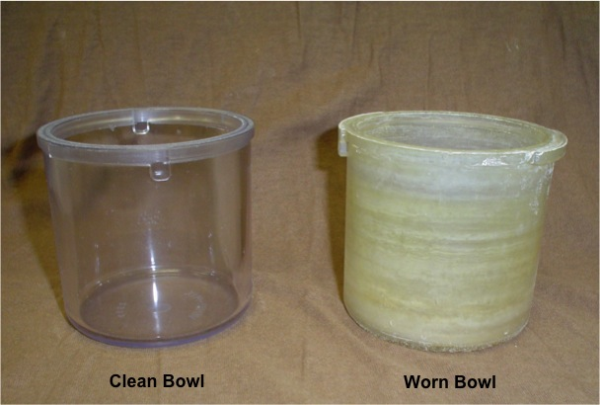 It’s happened again! A well-seasoned technician finally called after exhausting all of his thoughts and considerations on the topic, and said, ‘I’m right in the middle of a box of investment and I haven’t changed anything I’m doing, but my castings are all of a sudden too large. I’ve tried changing ratios but now I’m just lost…What is going on’?
It’s happened again! A well-seasoned technician finally called after exhausting all of his thoughts and considerations on the topic, and said, ‘I’m right in the middle of a box of investment and I haven’t changed anything I’m doing, but my castings are all of a sudden too large. I’ve tried changing ratios but now I’m just lost…What is going on’?
After reviewing all of the procedures for investing and finding that he was following them all correctly, he let go in conversation how he had just replaced his bowl he’d been using for 10 years with a new one.
Well, that is the answer. I know…you think that I’m just trying to sell more mixing bowls, right? But no, there is a physics issue going on that explains what’s with the bowl; and it will happen to you too if you are not aware.
The Science Behind Mixing Bowls
You are mixing a granular material and as you mix, the inside of the bowl wears away. This happens slowly and over time. As the inside surface of the bowl moves away from the edge of the paddle, the material against the bowl wall is actually mixed with less force than the material against the paddle. This force puts friction energy into the mix and that helps drive the reaction. The investment on the inside wall does not have as much energy and therefore does not expand as much as the material against the paddle (could this also be part of the problem with your bridge not fitting?). Because it happens over such a long time you really don’t notice the change or perhaps you start to notice that the units are getting tighter and you can’t get them much larger, even with straight liquid and no water. You look at your bowl at year 10 and say, gee it looks worn out; I should replace it. When you do, all of the expansion you were missing comes roaring back with a vengeance! “But I haven’t Changed anything”… well you changed a big part of the system without realizing you did. All of these materials and machines and parts are interconnected to produce your desired result.
A dental lab in Washington State proved this to me several years ago. There were two labs in town, both using the same investment. One was doing fine and the other could not get the expansion they wanted. With all other things being equal the two labs exchanged investment. Lab number two had the same fine results; the original lab number one with lab number two’s investment still had expansion problems. The owner finally said “I just don’t get it. The only thing different is that the other lab is brand new with new equipment”. I asked if he had a spare new bowl, and would he try it out. He called the next day, and he had more expansion than he wanted.
We all know that we have to replace worn out tires, worn out belts and other parts on machines and although we don’t like to, we know it is necessary. The same is true with mixing machine parts and even bowls. Depending on your usage we recommend that you replace the bowl every two to five years to keep the system you have in place consistent. That old bowl won’t be a waste. They make great tool holders, parts holders and brush holders near the sink. The best part about that is, they never wear out doing that job!
